Welcome
We continue our European Vacation this week.
Signposted as ‘Lutherstadt’ (Luther town), the German town of Wittenberg was put on the map by its most famous resident, reformer Martin Luther.

Having undertaken my Master’s thesis on Bible printing, with the core theme of the Reformation, it was a thrill for me to visit. Unfortunately, LutherHaus is closed for renovation until 2025, so we were not able to visit its exhibitions this time round.
This just means a good excuse to go back again another time!
Thanks to all of you who message & comment back to me each week, I would love to hear from more of you. Please consider leaving a comment on Substack about this or previous issues.
Let me know what you think of Traveling Through History.
Michelle
Savvy Travel Historian
January - European Vacation
Wittenberg - Germany
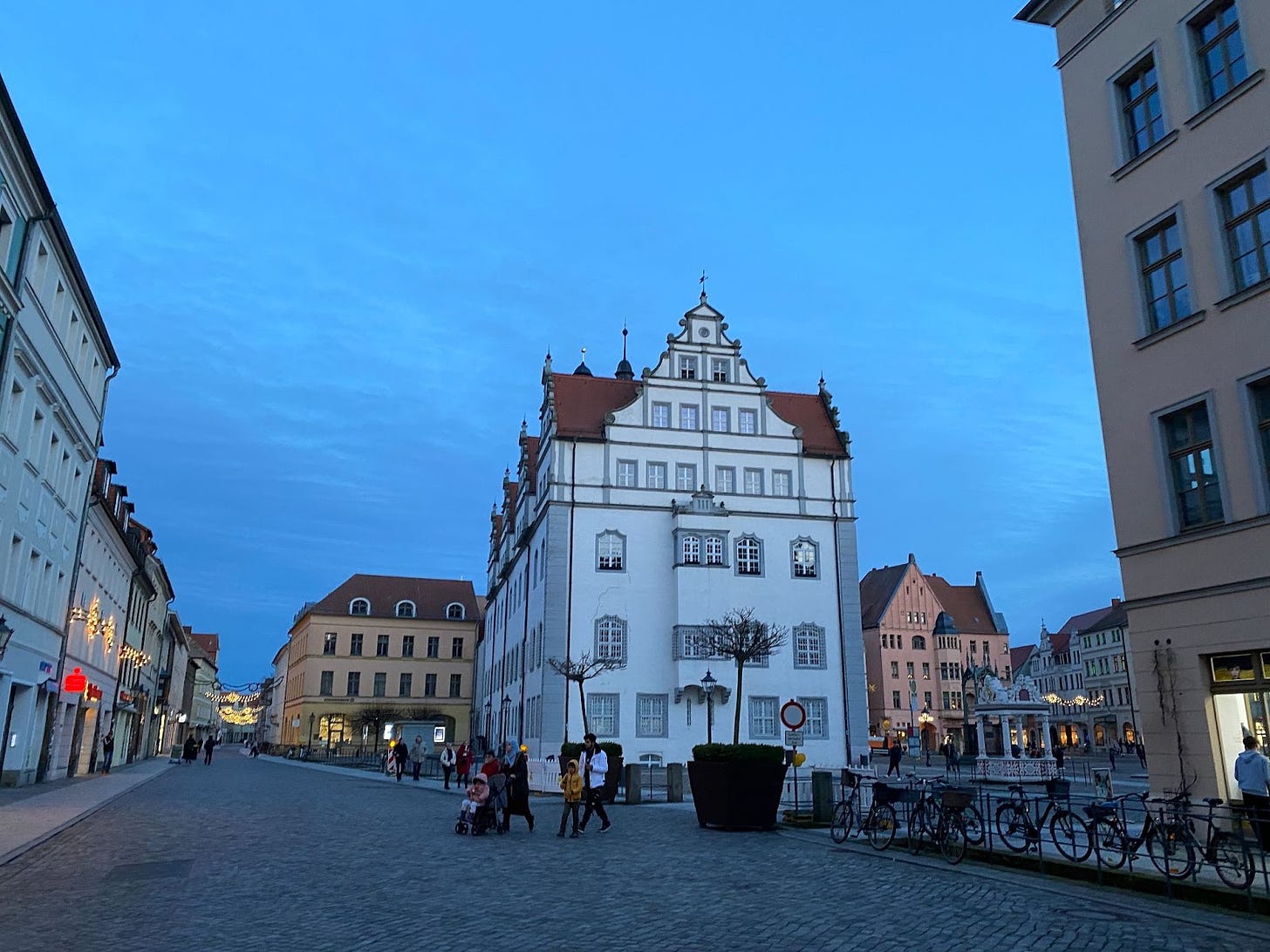
Background
Known as Lutherstadt Wittenberg, the town was at the centre of the Protestant Reformation due not only to it’s most famous resident Martin Luther but it was also the home of Phillip Melanchthon (collaborator and great friend of Luther’s) and renaissance and reformation printer and painter, Lucas Cranach the Elder.

Located 116km south-west of Berlin, it is an easy hour and a half drive on the autobahn.
History
The first flemish settlement record in the area of the town dates back to 1180 and for the next few centuries, it prospered as a trade centre due to its central location.
When Frederick ‘the Wise’ III, the Elector of Saxony made Wittenberg his home from 1486-1525, it gained an important political and cultural focus.
In 1502 he established the University of Wittenberg, which would set up the arrival of Luther and the town's connection with the Reformation.

Luther was appointed Professor of theology in 1508.
It was here in Wittenberg on October 31st, 1517, that Luther nailed his 95 Theses to the door of the All Saints' (Castle) Church, determined as the critical event that sparked the Protestant Reformation.
During the seven-years war (1760), the Austrian’s bombarded the Prussian controlled town, and in 1806 the French took control of it, with Napoleon refortifying it in 1813.
By 1815, Wittenberg became part of Prussia and during WWI it contained a prisoner of war camp. The town was spared bombings during WWII when the allies agreed they would not destroy it, although fighting did take place there.

In 1949 it became part of East Germany and has been governed democratically since 1990, after the fall of the Berlin Wall and the eastern bloc.
In 1993 for the 125th Anniversary of Luther’s Movement in Worms, towns and cities where Luther lived or played an important role were designated the status of ‘LutherStadt’. Eisleben, where Luther was born and died, along with WIttenberg, officially changed their names to add Lutherstadt.

The Union of Lutherstädte, comprises 16 towns.
In 2014, Lutherstadt Wittenberg was awarded the title of ‘European City of the Reformation’.
Preserved as a UNESCO World Heritage site, Wittenberg remains a symbol of religious transformation and a testament to its influential past. Its architecture, including the Schlosskirche (Castle Church) and Stadtkirche (Town Church), where Luther preached, continue to draw visitors interested in the history of the Reformation and early modern Europe.
Its listing can be found here:
https://whc.unesco.org/en/list/783/
Wittenberg’s Famous Residents
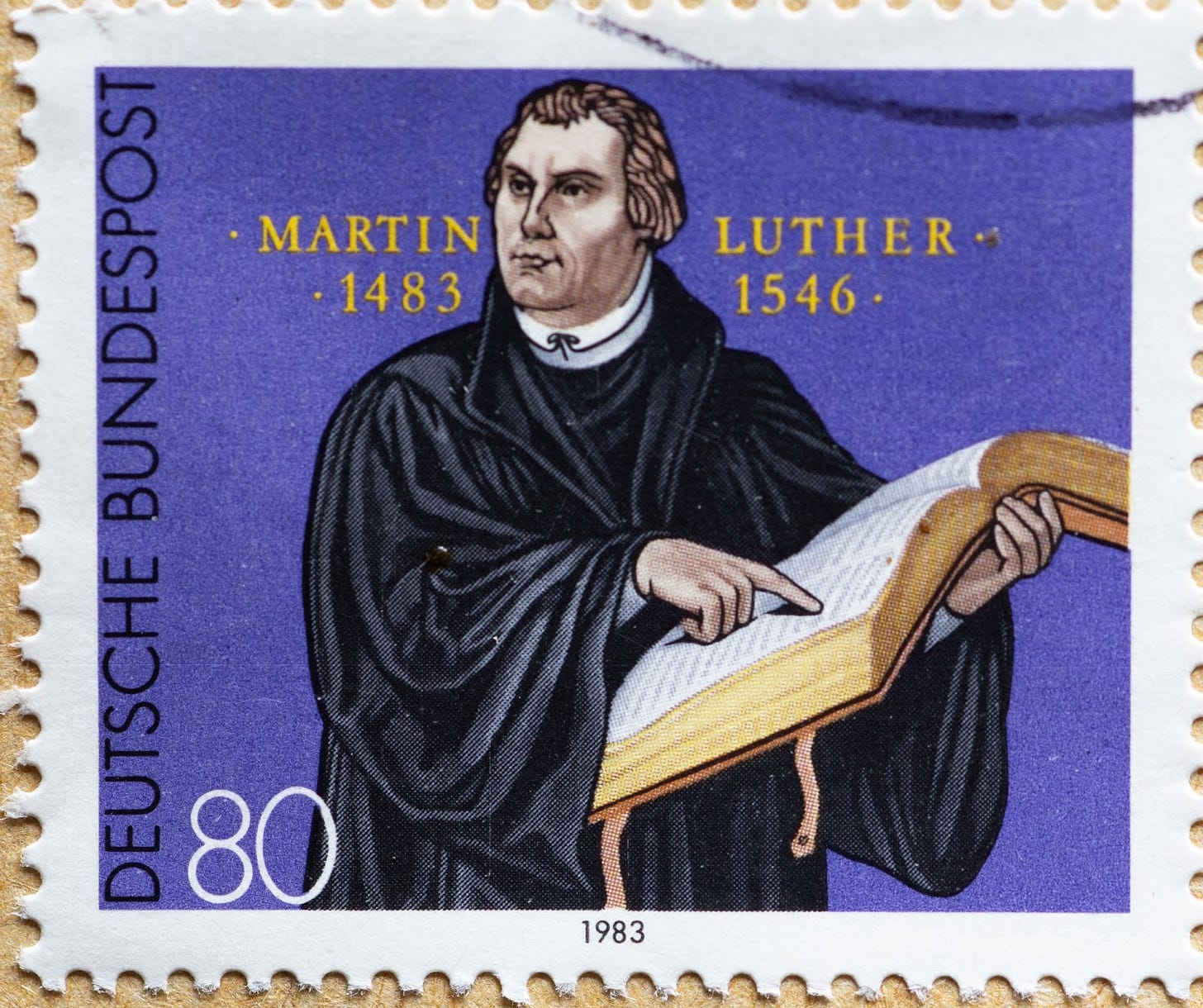
Martin Luther
As mentioned, Luther arrived in 1508 to work at the University. At this time he was an Augustinian friar and in 1511 was given his final appointment to the monastery, today known as LutherHaus.

In 1521 whilst on his way back from the Diet of Worms, Frederick III ‘staged’ an abduction of Luther and he was held in Wartburg Castle for three months. This was needed to ensure he returned to Wittenberg safely, as his life was in danger due to the Edict of Worms, declaring anyone could kill him without consequences..
It was here that Luther began translating the Bible in German. Until this time, there was no common German language, as each region had their own dialects. The largely illiterate population could not read Latin, the language of the church and the Bible.
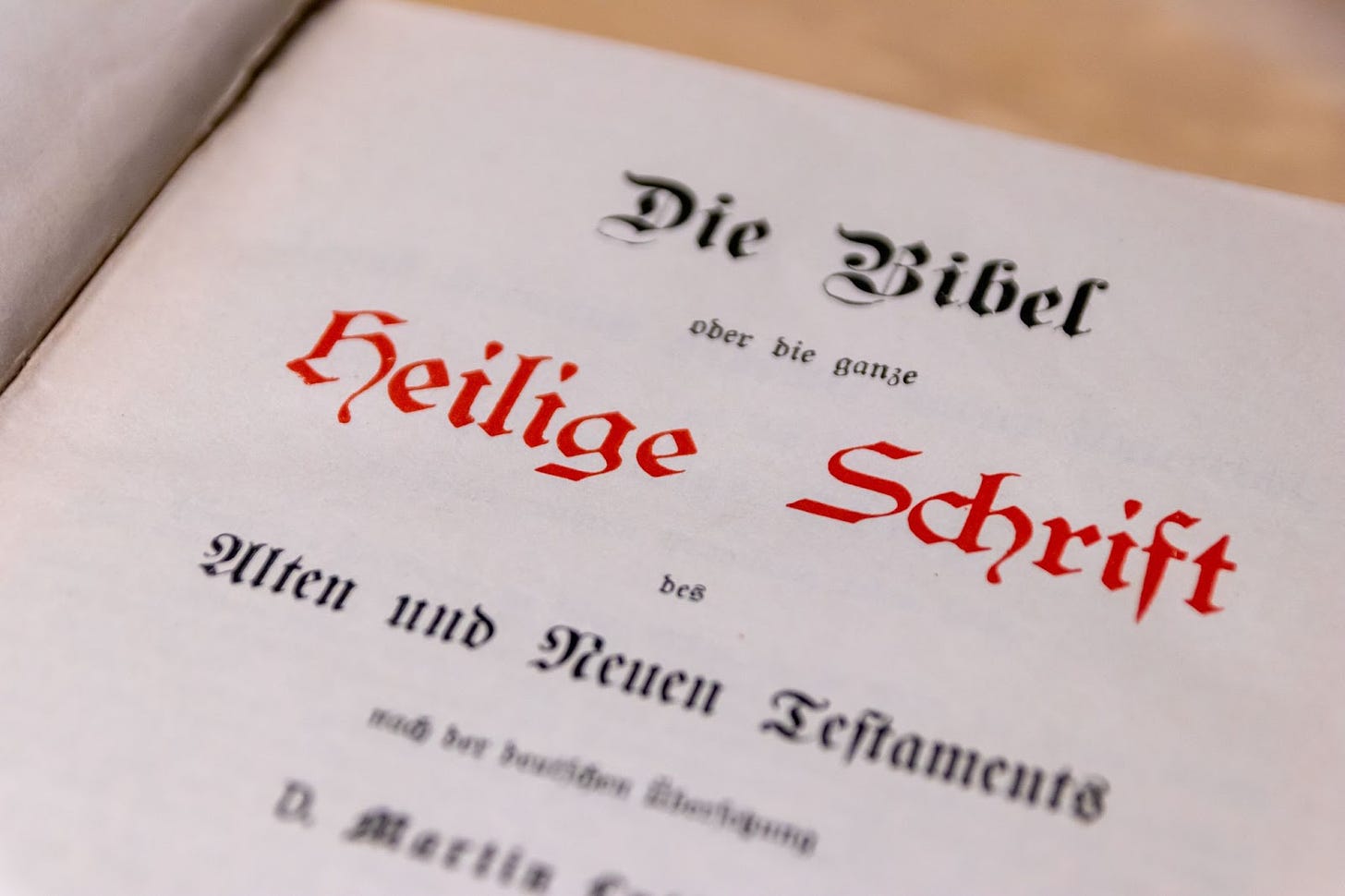
Having moved a lot during his life, Luther was able to understand many of the dialects around the country and was able to meld high and low German dialects into a more common and understandable language.
This enabled people to learn to read the Bible for themselves, without interpretation from priests and the Catholic Church’s version. One of Luther’s biggest objections was that there was no mention of purgatory or indulgences in the Bible and he felt that the Church was conning people by these practices.
The 95 Theses

On October 31, 1517, Luther posted his 95 theses, against the abuses of catholic church indulgences, on the door of the castle church in the town (shown above).
Essentially, Rome ‘sold’ the ability to pay off the time you spent in purgatory, between death and ascending into Heaven.This meant that rich people could pay for prayers to be said for them after death to speed up the time they spent ‘waiting’.
The profits from indulgences paid for the construction of St Peter’s Basilica in Rome.
Luther (and subsequent reformers like William Tyndale in England) believed that a person’s ability to get into Heaven was not something that could be paid for. It was solely dependent on faith alone and God’s automatic forgiveness for our sins.
Scholars don’t believe it was Luther’s original intention to change the course of religious history but the result was to become the largest schism in Christianity, the ramifications of which are still seen today. Without Luther, there would be no Protestantism.
In 1524 Luther ceased being a monk and married a former nun, Katharine von Bora and they lived and worked in Wittenberg, and had three sons and three daughters.
Luther spent much of his life (from 1517 - 1546) in danger due to his reformist ideas and teachings. Whilst he gained a lot of friends and supporters, those loyal to Rome and the Pope pursued him until the end.
In 1520 Pope Leo X issued a Papal Bull against Luther (shown below) demanding he recant forty-one of his theses, which were determined to be heretical, scandalous and offensive to pious ears. If he did not do so within 60 days, he would be ex-communicated.

Luther’s refusal to do so, resulted in his ex-communication in 1521 and this created an even wider division within the church.
The Wittenberg town square has a prominent statue of Luther on display that was hidden away during WWII in case it was destroyed.

Unveiled in 1821, it was designed by Johann Gottfried Schadow and was the first public full sized monument that was not of a nobleman.
It depicts Luther holding a Bible opened to the New Testament page.
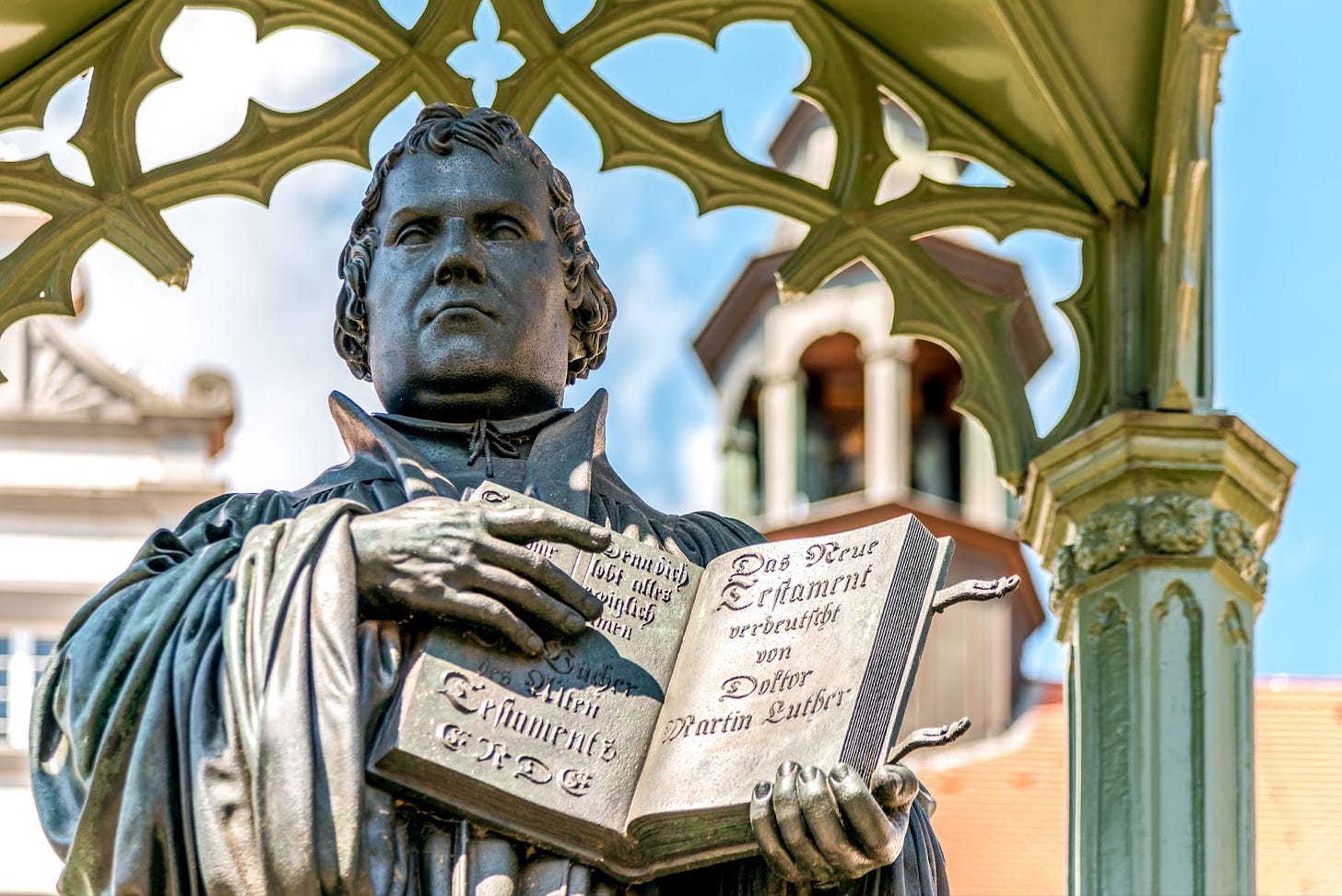
LutherHaus Museum

The LutherHaus Museum is the former monastery Luther was in charge of, given to him and his wife in 1532. After their deaths, the house was used for various pursuits, mainly in education (Luther School) and after renovation one part was opened as a museum in 1883.
The entire UNESCO listed site is now dedicated to Luther’s life and work and is the largest Reformation museum in the World.

The museum is currently undergoing an extensive renovation and is closed until April 2025.
https://lutherstadt-wittenberg.de/en/see-discover/sights/luther-house
Google arts and culture offer an immersive tour of the museum and can be viewed via the following link:
All Saints Church (Schlosskirche - Castle Church)

Like many old towns in Europe, Wittenberg has numerous churches, but its most famous one is that where Luther posted his 95 Theses.

A fire during the seven-years war in 1760, resulted in the Church being all but destroyed and the original wooden doors did not survive.
After Wittenberg became part of Prussia, King Frederick William IV commissioned commemorative bronze doors (weighing 1,000kgs) to be created and placed back in the original slots and had transcribed the 95 Theses in Latin onto them.
The installation of the doors were commemorated in November 1858, some 375 years after Luther’s birth.
Placed above the doors is what’s known as a tympanum, which has an image of Christ on the cross, with Luther on his left holding a Bible and Melanchthon on his right holding the Augsburg Confession.

Luther is buried inside the Church.
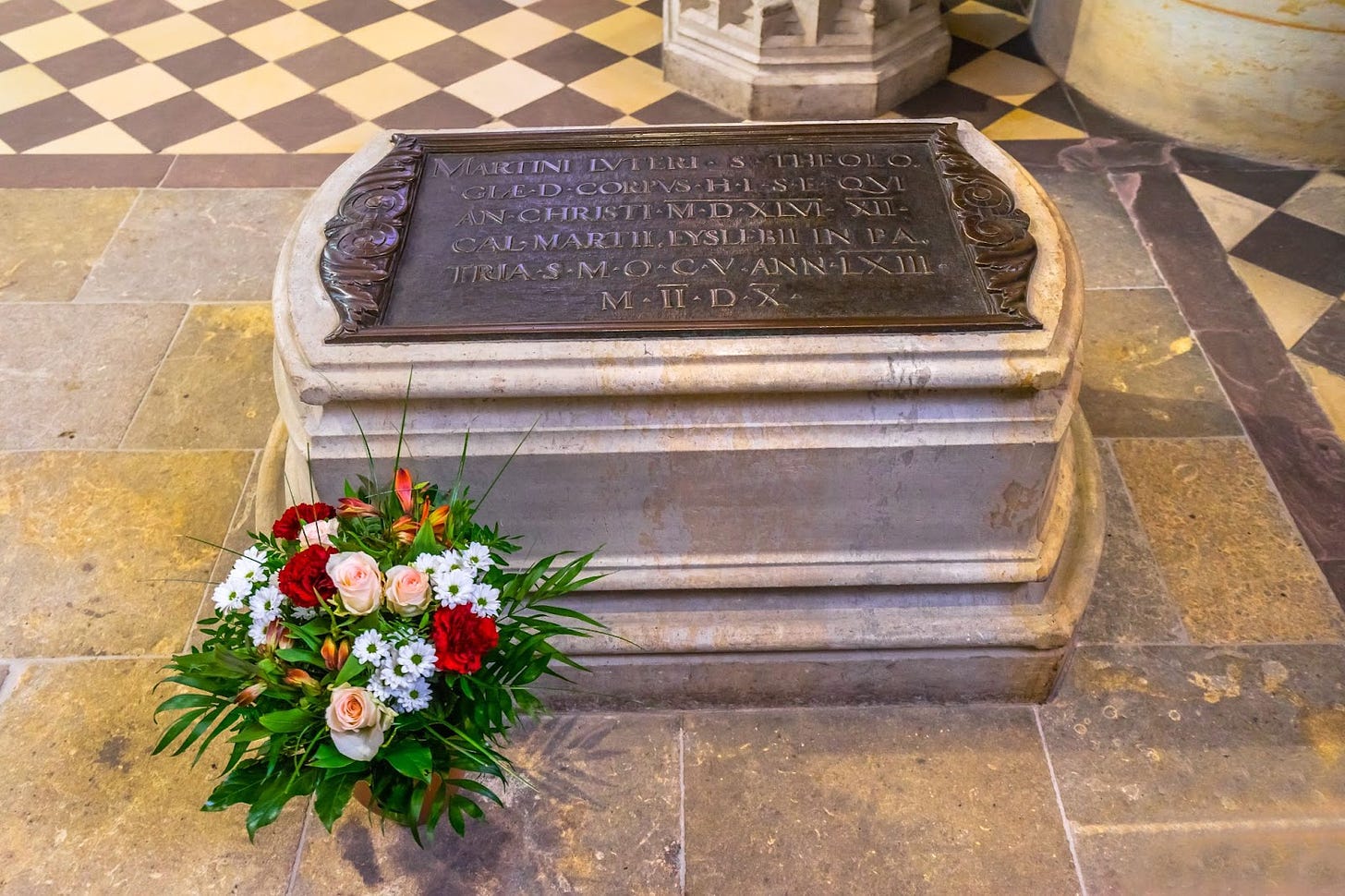
Philip Melanchthon

Philip Melanchthon arrived in Wittenberg in 1518 as Professor of Greek at the young age of 21.
He was a child prodigy, denied a Masters degree in 1512 at the University of Heidelberg due to his youth, so he moved to Tübingen and gained it there. He was considered one of the most eminent thinkers of Greek philosophy at the time. His theological thinking shifted early and after opposition from others in the Theology faculty at Tübingen, Luther invited him to Wittenberg.
They were to become lifelong friends.
A brilliant scholar, it was thought that without Luther, Melanchthon could have been a ‘second Erasmus’ and has been described as the ‘Teacher of Germany’ due to his work on the reorganisation and design of the education system in the country.
Wittenberg University became a model for how Protestant Universities would be framed in the future.
Melanchthon wrote the ‘Augsburg Confession’, which is on of the main underlying teachings for modern day Lutheran and the Book of Concord.
After Luther’s death in 1546, he became the face of the reformation in Germany until his own death in 1560.
He is buried near Luther in Castle Church and has a prominent statue in the town square, not far from Luther’s own.
Melanchthon House

Considered one of the most beautiful Renaissance houses in Wittenberg, the house where Melanchthon and his family lived is now a permanent museum, dedicated to his life and work.
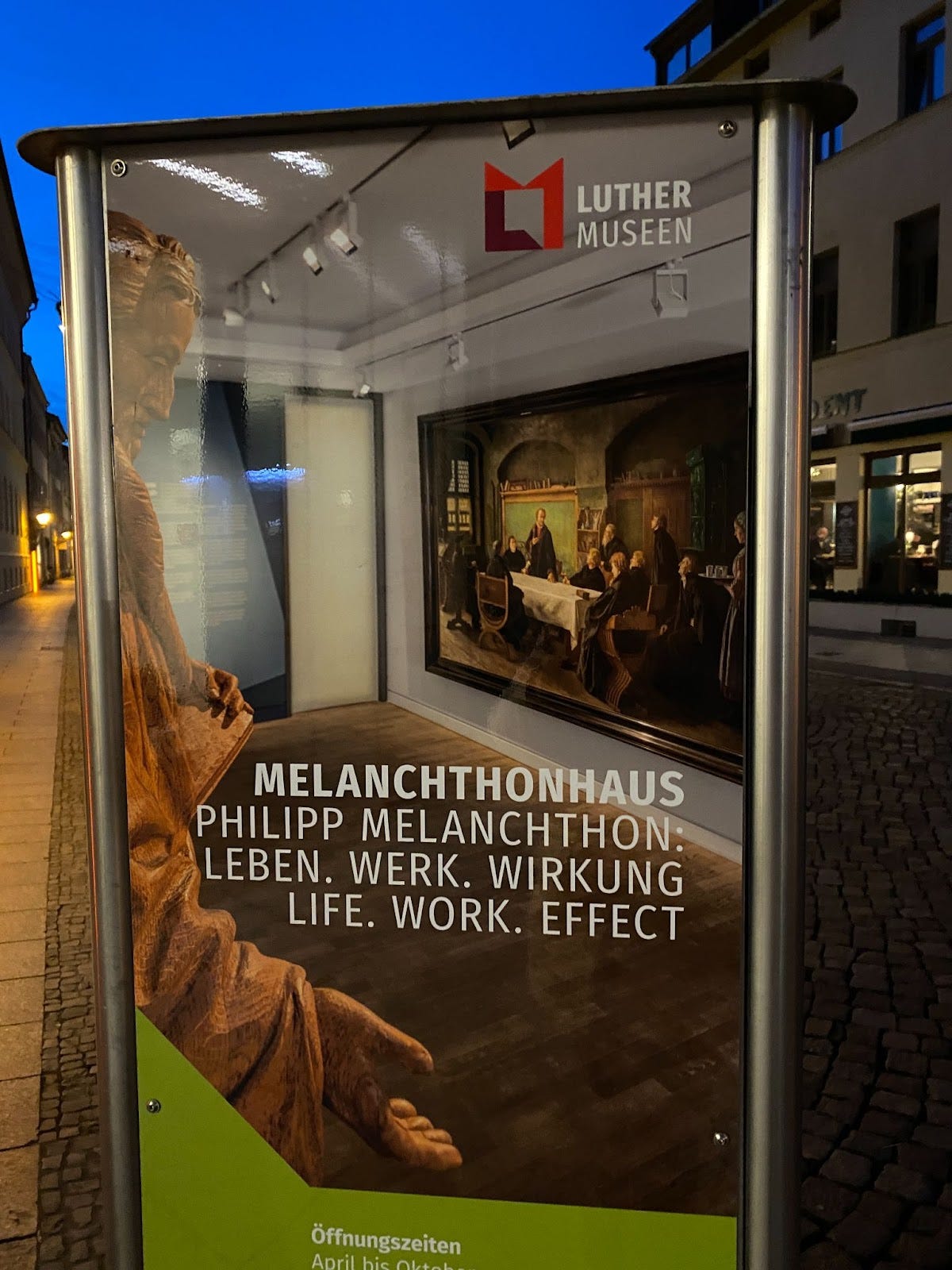
Details on visiting can be found here:
https://lutherstadt-wittenberg.de/en/see-discover/sights/melanchthon-house
Lucas Cranach the Elder
Considered one of the greatest German painters of his time, Lucas Cranach the Elder, was appointed Court painter by Frederick III in 1505 and remained in this position until 1550. He died in 1553 and was succeeded by his son Lucas Cranach the Younger, also an artist.
Cranach’s role in the dissemination of the Reformation ideas can not be underestimated.
As well as being a painter, he was a printer and woodcut artist. He was to provide all of the illustration woodcuts for Luther’s early Bibles and was given the exclusive license for Bible printing is Saxony.
It is not known when he and Luther officially met, but Luther’s first reference to him in correspondence is 1520 and Cranach made an engraving of him that same year. Luther’s first born son, was to have Cranach as his Godfather.
Now part of the Medici collection in Florence, these portraits of Luther and his wife Katharine (from 1529) are amongst some the most recognisable Reformation imagery.
This portrait of Luther particularly, is widely used, even today.
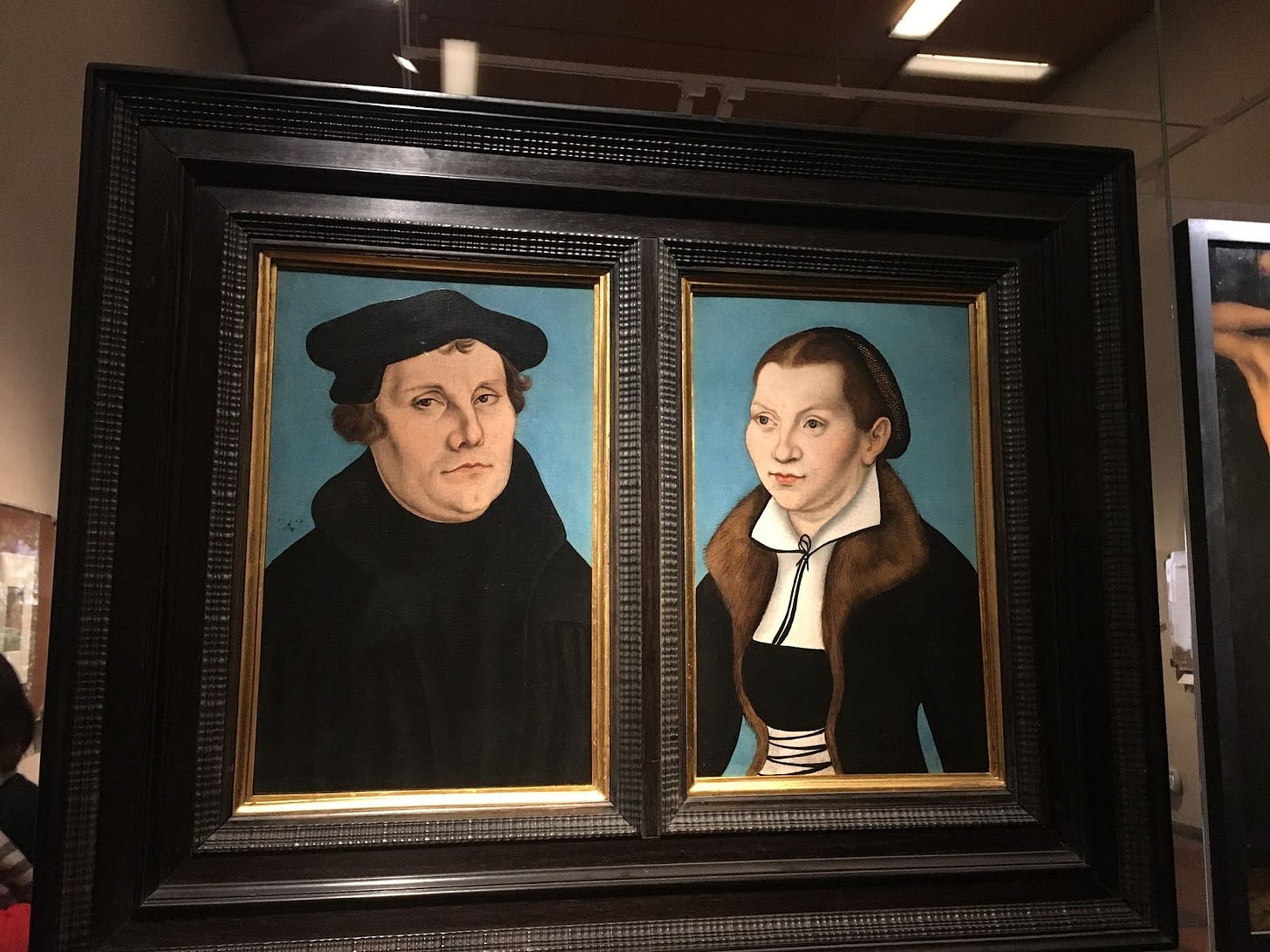
Cranach also painted Luther and Melanchthon in 1532-3 and these were touched up in 1543 to portray a more harmonious relationship and connection between the two.

Cranach became a wealthy man and created other businesses in town including the apothecary (pharmacy), which survived for centuries until a fire destroyed it in 1871.
Amongst some of Cranach’s most notable printed works include this pamphlet by Luther and Melanchthon, which contained two celebrated woodcuts depicting monstrous beasts whose birth symbolises God’s condemnation of the Pope.

A treatise by Luther shown below and written in 1527, contains an elaborate frontispiece created in Cranach’s workshop.

Printed matter that included images such as those shown helped spread the Reformation message, as they assisted with interpretation amongst those who could not read.
Like that in England later that decade, the printing press’ role in moving the reformation message further than ever before, can not be underestimated. Cranach’s visual imagery and his print shop played a crucial role in not only spreading but shaping the changes to come.
The Nazis had a fascination with Cranch’s works and looted many of them from towns they occupied and Jewish families they sent to concentration camps. Since the end of the war, many disputes between current owners, whether private or galleries, have been fought in the courts, with paintings often returned to the families from whom they were originally stolen.
Cranach’s house and farm can still be visited.
Reformation Day
Germans have celebrated Reformation Day since 1567, although the exact date was not settled as Oct 31st until 1717, on the two hundredth anniversary of Luther’s 95 Theses. The 500th Anniversary in 2017 was declared a national public holiday.

We were in Germany in 2017 and Martin Luther Playmobil (Lego type figures) were available for sale in celebration of the 500th Anniversary of the Reformation.

Additionally, a board game was created, which allows four players to travel to all the significant locations Luther went to in Germany during the dissemination of the Reformation ideas.
Sadly, we did not purchase either of these, as I had only just started my studies at Oxford and was yet to become fascinated with the Reformation!
In a spirit of reconciliation, the Vatican issued a commemorative stamp for the 500th Anniversary, depicting Luther and Melanchthon kneeling and is the image above the castle church doors in Wittenberg.
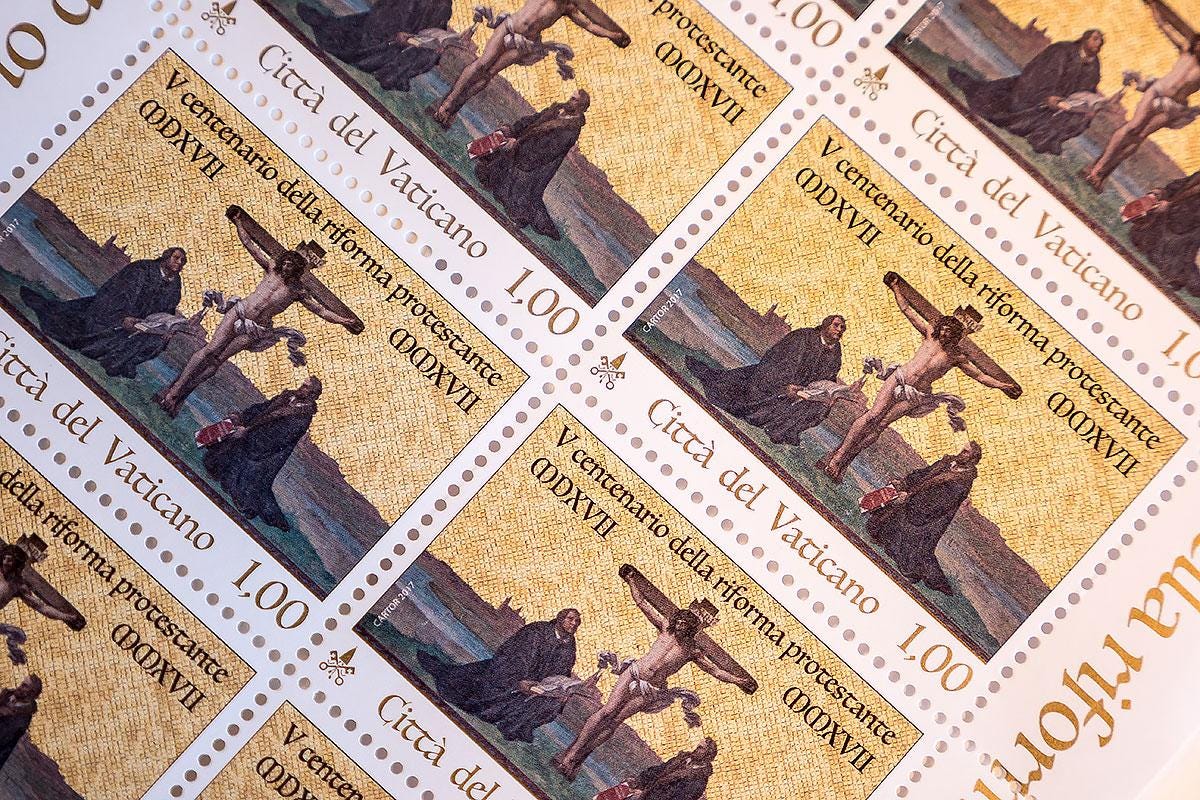
Next week we continue our European Vacation and arrive in Berlin. See you then.

Michelle is a speaker, author, content marketer, historian and mother of 3 boys.
After 25 years in business and as the ‘Content Marketing Queen’ for the past 12 years, she has helped countless small businesses understand and develop their content strategies and focus on a customer first approach.
Savvy Travel Historian is her passion project, and her weekly newsletter is available on Substack, Paragraph and Mirror. The latter two allows you to collect each Issue as an NFT.
Michelle is co-host of the Business on the Bloc podcast, a weekly show which talks about the digital media revolution and how it applies to B2B marketing, sales and operations. The show is recorded live every Wednesday at 4pm EST/ 9pm UTC on LinkedIn, YouTube & Bolt+.
You can follow Michelle in these places:
Savvy Travel Historian Instagram

